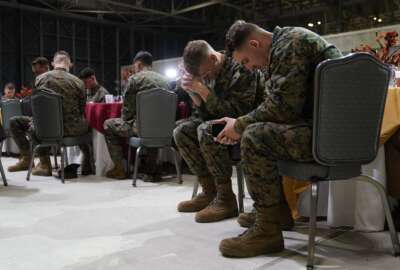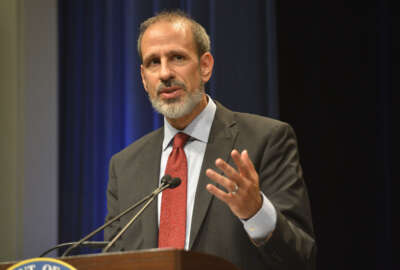How are CRs impacting agencies?
Continuing resolutions hurt not only service members, but also civilians both at the Department of Defense and at other agencies by hurting morale and slowing new...
While a government shutdown has been averted for the second time this year, the pattern of continuing resolutions (CRs) is still impacting military service members, civilian federal workers and their families. The focus can often be on the numbers and getting funding passed, but appropriations and continuing resolutions have a human impact too.
The Defense Department impact
For example, during the 2013 shutdown that impacted the Defense Department, it not only affected service members, but also DoD civilians, said John Polowczyk, an executive director at Ernst and Young and a retired Navy Rear Admiral, who also was the supply chain lead on the White House Coronavirus Task Force and Joint Staff vice director for logistics.
“The Navy is a multi-dimensional team and people forget about the role the civilian employees play,” Polowczyk told Federal News Network.
During the 2013 sequestration he served as comptroller at Fleet Forces Command. He shared a story about a civilian he worked closely with and the impact the shutdown had on her.
“I had an office manager, she managed calendars for me and my deputy, she managed the workflow, things coming in from the front office that had to be chopped through comptroller, she also managed some additional workflows for the office for keeping the trains running on time and financial reviews and other things. She was an integral employee,” Polowczyk said. “In the run up to sequestration, she was out of her mind in stress, which really impacted her performance. And, she started taking care of her mother. And her only outlet was a horse that she had. She was so stressed by the furlough that she made a decision to get rid of the horse because she wasn’t sure [that] if she was furloughed if she was going to be able to take care of it. And I remember that story like it was yesterday. And the angst and anxiety. So here she’s working in the comptroller shop, she’s at the front row seat of everything going on financially across the command. And we tend to talk about our sailors, but from that shutdown and that furlough action, the civilian employees took the brunt of that. I just remember the stress.”
He went on to say that shutdowns and CRs have an impact across the workforce for both military and civilian personnel. If civilian workers are not there and a service member needs something that a civilian does, it impacts the workforce. There can also be an impact if there are furloughs people are not sure when they will get their next paycheck or uncertain how they will make ends meet. All of this can have an impact on morale.
“It absolutely impacted the morale, especially the civilian workforce,” Polowczyk said. “You don’t even have to shut down the government, you just have to walk towards one of these events and the stress for some people goes up. And, I still to this day, I just think about every time we talk about this, I’m like, ‘Oh, God, she sold her horse because she was like, I don’t know how to make ends meet.’”
Continuing resolutions can affect all government agencies in a variety of ways. For example, with the Navy the money must be in the proper account to use for specific things, or money needs to be moved around into the right account to do something. Secondly, personnel only have so much bandwidth to address issues.
“The continual stopgap funding disrupts the cycle of life within the budget realm,” Polowczyk said. “I just think about how we held off doing something over here to allow the money to be over here, because they weren’t all in the right pots until the actual appropriation got authorized and signed into law by the president. The disruption to work and holding off on something so you can take care of these emergent issues just adds to the force. I just think about training events, things that the force needs to buy to keep readiness prepared. So this up and down leads to behavior that’s not conducive to running an organization.”
“As you make budget changes, you can’t go make those changes until it’s for real, so things get delayed and delayed and priorities change and then all of a sudden, it’s hurry up and go execute,” Polowczyk said. “And then the contracting people, the people that actually have to obligate the government, they only have so much bandwidth.”
Congress’s pattern of kicking the can down the road by passing several CRs instead of full appropriations can significantly affect large acquisition programs because of the impact it also has on industry, which then goes back to impact DoD and its personnel.
“It really impacts the large acquisition programs where you’re trying to give a steady demand signal to industry,” Polowczyk said. “Industry responds well to a steady, long-term picture that they can invest to.”
He said that if industry is not sure if there will be funding or interest in a certain area then it will not invest and innovate in that area. For example, the U.S. has a submarine production challenge, which can impact sailors and civilians.
“I am pleased that the passage of another continuing resolution has put off the threat of a lapse of funding,” Defense Secretary Lloyd Austin said in a press release. “Its enactment will ensure that our brave troops and dedicated civilian workforce will be paid through the holidays. Yet I continue to urge Congress to pass full-year appropriations, which remains the best thing that Congress can do for our national defense. As we have long made clear, operating under short-term continuing resolutions hamstrings the department’s people and programs and undermines both our national security and competitiveness.”
Meanwhile, Air Force Secretary Frank Kendall said that a government shutdown or continuing resolution, greatly affects the service’s ability to operate and perform the mission. He compared the impact of a CR to a race.
“If you’re doing a race that’s a mile long, we’re essentially giving away a quarter mile head start to the other side; a quarter mile,” Kendall said. “If you add up over four years, those four periods of three months that we customarily now don’t have appropriations or authorizations, that’s like a quarter of our time. You’re giving away an entire lap in a four-lap race to the other side to move ahead while you’re sitting still. That makes no sense whatsoever.”
There are several implications for having CRs instead of permanent funding.
“We can’t spend money we don’t have yet,” Kendall said.
For example, the Air Force cannot increase funding for programs it’s ready to ramp up. As a result, for instance, production rates cannot increase and must be kept the same.
“A good example of that is our C3 battle management system, the Advanced Battle Management System, which is the Air Force and Space Forces’ part of Joint All-Domain Command and Control; we intend to double the budget for that effort in ’24,” Kendall said. “We will be kept at half the rate at which we’re prepared to spend if the bills don’t pass or until they pass, so that has a big impact. You can’t hire people. You can’t put contracts in place. And if you do, you have to limit the scope of work to them. In the case of production programs, you can’t do multiple years and you can’t increase production rates in programs where you’d plan to do that. So, it just holds us back. It’s like an anchor keeping us [from] moving forward.”
The impact on other agencies
There are repercussions for the rest of government when there is a shutdown or several CRs. For example, during shutdowns, basic government functions can stop or be reduced, including closed national parks, stopped food safety inspections and disruptions to air travel. It also means that some employees will be furloughed.
“These stopgap measures hinder innovations in technology, operations and staffing that our government needs to deliver services more effectively, forcing agencies to live with a fiscal uncertainty that prevents them from making long-term, strategic decisions. No private sector organization could function effectively under such constraints, and our government should not be expected to either,” the Partnership for Public Service said in a blog post.
Moreover, the Peter G. Peterson Foundation said that CRs should be rarely used, but are being used more frequently.
“While CRs can help avoid government shutdowns, they should be seen as stopgap measures and rarely used. However, CRs have become the norm over the past few decades. That unfortunate practice can lead to disruptions in the federal budget process, hinder lawmakers’ ability to properly and efficiently match resources with needs and restrain agencies from carrying out their missions effectively. CRs are consistently used by lawmakers to fund the government. Since fiscal year 1998, policymakers enacted 133 continuing resolutions — an average of about 5 per year,” the foundation said in a blog post.
CRs can lead to more work and delayed: hiring, contracts and grants. It can also add more work, according to the Peterson Foundation.
GAO did a report in 2009 about the impact of CRs for some civilian agencies. It found CRs caused uncertainty, limited management options and an increased workload. They caused inefficiencies and delays in things like hiring as well as repetitive work.
Other DoD implications
This can also have a large impact on the quality of life for service members. For example, a September Government Accountability Office report found that many barracks are in poor condition, with issues like sewage overflow, broken heating and cooling, fire systems that do not work and mold. GAO found that one of the reasons for these poor conditions is “chronic underfunding and neglect.” DoD anticipates that the next budget release will have a multi-year investment strategy to help fund fixing this issue. CRs can exacerbate this issue by delaying funding to fix the condition of this housing and cause deferred maintenance.
CRs can also impact service members with things like childcare. They can also cause more stress and uncertainty. June’s debt limit law exempts military personnel compensation from sequestration cutbacks, which would trigger an automatic 1% budget cut if all 12 appropriation bills are not passed by January 1. Therefore, cuts would have to come from other categories like facility and equipment maintenance and new weapon investment.
A 2021 GAO report looked at the impact of CRs on DoD, notable challenges include hiring fewer civilians, program delays and acquisition constraints.
“It is an important time to ask elected officials to put aside their political differences, lead by example, and keep to the schedule,” Mark Belinsky, director of currently serving and retired affairs at the Military Officers Association of America, told Federal News Network. “The work on appropriations should have been complete before Congress went on summer recess and is still incomplete. Our uniformed servicemembers do not have the luxury of going on recess or vacation when their mission is not complete, and Congress should stay in session, suspend all travel and get the job done.”
Copyright © 2025 Federal News Network. All rights reserved. This website is not intended for users located within the European Economic Area.
Kirsten Errick covers the Defense Department for Federal News Network. She previously reported on federal technology for Nextgov on topics ranging from space to the federal tech workforce. She has a Master’s in Journalism from Georgetown University and a B.A. in Communication from Villanova University.
Follow @kerrickWFED






